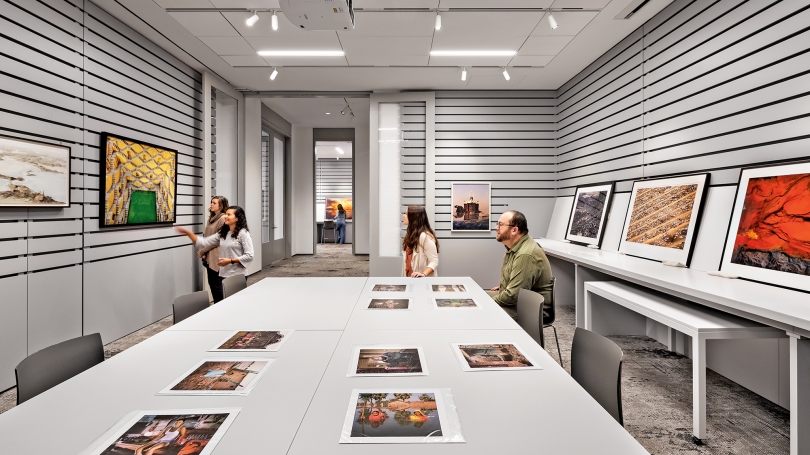Nils Nadeau, Associate Director, Strategy and External Relations
Hood Quarterly, winter 2019
What does it mean to physically expand a cerebral notion? This is the Hood Museum of Art’s purpose: The Hood Museum of Art at Dartmouth enables and cultivates transformative encounters with works of artistic and cultural significance to advance critical thinking and enrich people’s lives.
We are, in short, what we do with what we have, and how we make new discoveries possible for all who visit the museum. This axiom informs our physical spaces just as it does our collections (and collecting). So why more space? What are we saying when we decide to be bigger?
The following pages of this special issue of the Hood Quarterly answer this question from several perspectives: the architecture, education,
curation, and installation. As administrators concerned with the potential impact of a visit to the museum for each individual viewer, we understand that more space is about more engagement—with campus, with the community, with our peers and the art world and the world world. The museum has not simply expanded but rather refined and amplified our ability to meet people where they are (figuratively) in the spaces where we are (literally)—where we have built, through Dartmouth’s collected objects, a means for our visitors to see many things: art, creativity, personality, themselves, their neighbors, their countries, the world. In this new institution, we have opened our arms very wide.
The Hood and Dartmouth worked with Tod Williams and Billie Tsien to imagine new spaces, and with Abbott Miller and Pentagram to imagine a brand that would follow from that purpose
and those spaces, then turn around and lead the way for them onto our campus and into the contexts of our visitors. Just as the architects updated and expanded a museum for the twenty- first century, and the designer rebranded us by stitching those new bricks directly into our name, so do our building and branding commingle with our purpose and practice. We might even claim a signature porousness of purpose, space, and practice, in that we took the opportunity presented by Dartmouth’s endorsement of our expansion to recraft what we would want to do and how we would do it. And we deliberately extended that effort from purpose through practice to the staff, student, and volunteer activities we dedicate to those ends.
Existing spaces are as amenable to this process as new ones. It all begins with a commitment to understanding them differently—to reintroducing them, in a sense, first to ourselves as a museum staff and then to our audiences by way of a renewed purpose and look and feel of a brand. The Hood staff began there, reintroducing itself
to its spaces and imagining what other spaces would complement them best. First up in this regard, for the Hood, were object-study spaces, housed in a self-contained center with three study galleries and a dedicated object-staging room, an academic curator’s office, and a welcome desk and lobby area with cubbies and restrooms. Next up was a bold, readily visible façade on the Green and, beyond a new front plaza and the glass vestibule, a space of welcoming—in the Hood’s case, an atrium/event space with an expansive visitor services desk flanked by partnered entrances to the center for object study and the galleries, comfortable seating, multiple informational screens, the capacity to display art, and a connection to the Hopkins Center for the Arts, along with a coatroom and extra storage closets. Last but not least was more gallery space and a new suite of workspaces for staff, allowing us to regularly display more collection areas than before, including Native American, Asian, and contemporary Aboriginal Australian art, and allowing the original object-storage and staff areas to be repurposed or renewed in the context of the new museum. Tod Williams and Billie Tsien and their team responded to these needs with graceful and vigorous architecture that somehow still managed not to expand the museum’s footprint on its well-defined site.
These were practice-driven ideas and spaces, and from both their substance and their realization emerged the brand to lead them forward among all the other activity on a very competitive campus. The Hood’s expansion, that is, went beyond the façade both into the museum, in the sense that we are what happens behind it, and out from the museum, onto campus, in the sense that we now extend our reach further into the audience that principally defines us, students and faculty at Dartmouth, and welcome with renewed commitment our local and regional visitors, and particularly our region’s K–12 students and teachers.
There are as many ways to engage with this museum as there are visitors who arrive to do so. Drift quietly in, look at two objects, and leave without needing a thing: you are welcome. Visit with your dorm, your Greek house, your team, your club, or, of course, your class, and participate in a facilitated experience that activates an issue, an interpretation, the academy, or the tasks and techniques of art making: you are welcome. Share the Hood with your children or your parents or your colleagues or your friends: you are welcome. Along the way, we will be here for you, and here again to welcome you back. So, when you spot us in our lanyards or follow us online or pick up our Quarterly, know that the individuals behind all this activity are doing it for you because the art here is worth it, as a marvel in itself and a part of the narrative surrounding you and, in another way, all of us all the time. It will join in your dialogue, and it might share some thoughts of its own. With the new Hood, we can facilitate that conversation— that transformative encounter—in more ways than we ever could, thanks to the porousness we have placed at the center of our engagement.

